SOURCE:
Inventory Shortages & Gluts, by Retailer Segment: Where they Are and Why | Wolf Street
Overall supply at retailers still 18% below normal, huge shortages in some segments, gluts in others. Thankfully, grocery stores are only a tad below normal.
The retail industry measure of inventory levels – the inventory-sales ratio – ticked up to 1.21 months’ supply at the end of June, according to data from the Census Bureau last week.
This has come up from the empty-shelves era, but was still down by 18% from the average supply in 2019. And there are vast differences by segment of retailers, from relentlessly huge shortages at some, to slightly below normal at others, to overstocked at others.
New-vehicle dealers are still woefully low on inventory and essentially out of stock of fuel-efficient vehicles. The number of new vehicles in stock is down 70% from 2019. At other retailer segments, such as grocery stores, the shortages are over, thank goodness, but supply remains lower than it had been before the pandemic.
But some general merchandise retailers, such as Walmart and Target, ordered too much of certain items, and by the time those items finally got in, consumer spending had shifted to other items. More on those segments in a moment.
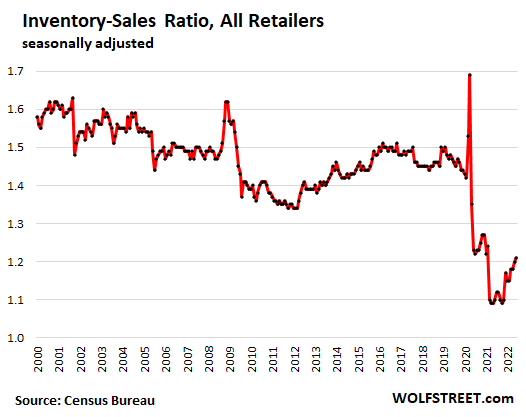
This inventory measure includes what is in the stores of that retailer, plus what is in the warehouses of that retailer. So this is not just what is inside the store, but the total inventory that the retailer holds including in its warehouses.
Patio furniture and some types of apparel are what Walmart brought up as problem items. Consumers bought a huge number of laptops and PCs and smartphones and networking equipment during the pandemic to work and study and sit at home, and now they’ve got all this stuff, and they’re spending their money on plane tickets to go someplace, and sales of some types of electronic devices, furniture, etc. are weakening, and inventories have built up.
The pandemic, from the very beginning, has made a mess of the normal game plan of retailers, and continues to do so. And Americans, notoriously fickle about their spending preferences, are at it again, with sudden shifts that can leave retailers with the wrong inventory.
Inventory in dollars shows raging cost inflation. What matters: months’ supply. Inflation in goods has permeated the entire supply chain, resulting in higher costs of merchandise for retailers. Higher costs push up the dollar levels of inventories, even if the number of items hasn’t changed. So the dollar-levels of inventories are not relevant to measuring if retailers are overstocked or understocked.
To eliminate much of the impact of the surging costs of goods on inventories, and to get a feel for what actual inventory levels are in relationship to sales, we look at the “inventory-sales ratio.” This classic industry metric shows how many months it takes to sell the inventory on hand at the end of the month at the current rate of sales.
At auto dealers, the inventory-sales ratio rose to 1.39 months’ supply, still down by 40% from the average 2.3 months’ supply before the pandemic. But there is a huge difference between used vehicle supply, which is nearly back to normal, and new-vehicle supply, which is still hampered by massive shortages, though those shortages have shifted from pickup trucks and large SUVs to fuel efficient vehicles – more on that in a moment.
Auto dealers are the largest segment of retailers by size of inventory, which in normal times account for over 35% of total retail inventories:
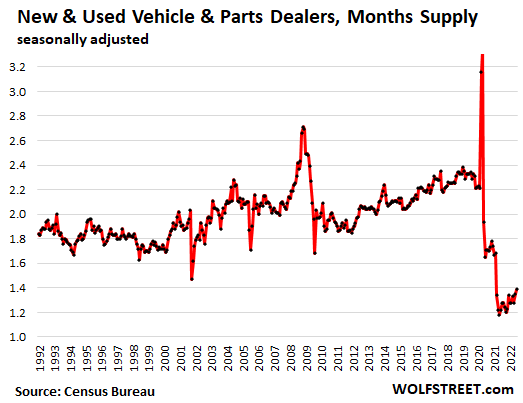
The number of new vehicles on dealer lots and in transit dipped further in July to just 1.09 million vehicles, down by 70% from the average level in 2019, according to data from Cox Automotive. But the mix of those inventories has changed in reaction to the spiking gasoline prices this year:
- Hot demand for fuel efficient vehicles has depleted inventories of minivans, sub-compact cars, compact cars, and midsize cars.
- But inventories of full-size pickups and SUVs are building, with some brands already at very high levels (Ram 1500 trucks):
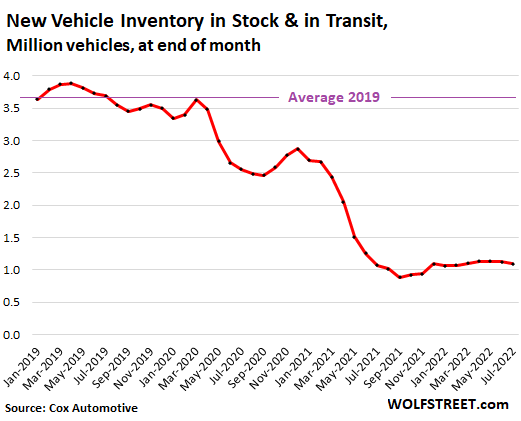
The number of used vehicles on dealer lots has remained flat for the past three months at about 2.47 million vehicles. This is only 14% below the average levels in 2019:
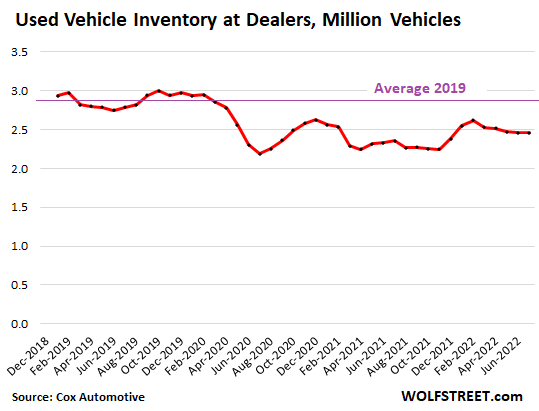
At food and beverage stores, supply has risen from the empty-shelves era – which is a really good thing – but it remains below pre-pandemic levels, and in June dipped to 0.77 months.
Note: This inventory measure covers what is in the organization’s stores, plus what is in the warehouses of the organization. Inventory levels at grocery stores are generally low as inventory goes through a pipeline, with new merchandise arriving daily, as merchandise is sold. But this measure also covers what is in the retailer’s warehouses and in transit from the warehouses to the shelf.
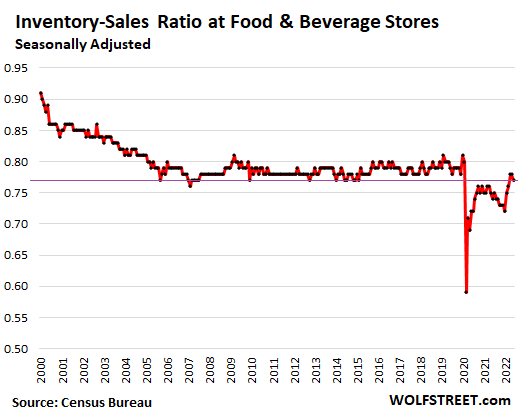
At building materials and garden supply retailers, the inventory-sales ratio rose to 1.93 months’ supply, the highest since 2012, as consumers have switched from buying patio furniture and materials for DIY projects, that boomed during the pandemic, to buying tickets for sports events, cruises, plane tickets, or whatever, to do what they’d missed out on during the past two years.
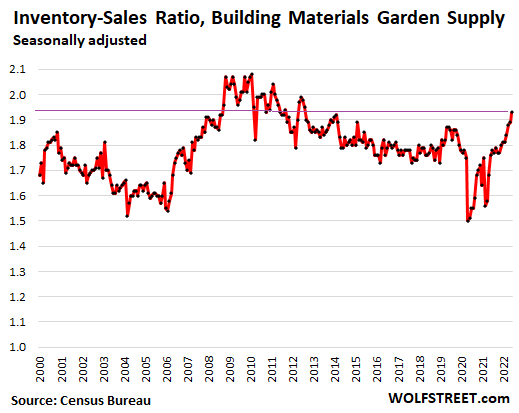
At clothing and accessory stores, the inventory-sales ratio ticked up to 2.22 months’ supply, up a long way from the out-of-stock levels in 2021, but still below the pre-pandemic levels of 2.4 months’ supply:
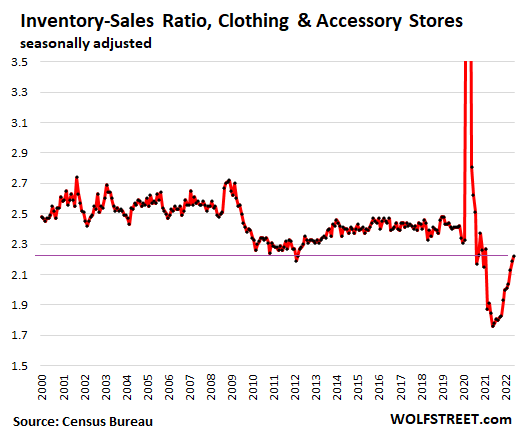
At general merchandise stores, the inventory-sales ratio jumped to 1.61 months’ supply, the highest since 2007, having solidly surpassed pre-pandemic levels earlier this year. This segment includes stores like Walmart and Target, and department stores.
The segment accounts for only 12% of total retail inventory. And it’s in this segment where overstock levels are now an issue that these retailers have acknowledged during their earnings calls. Retailers being overstocked is a classic and common problem, as consumer preferences shift on them, and they know what to do: Offer some deals.
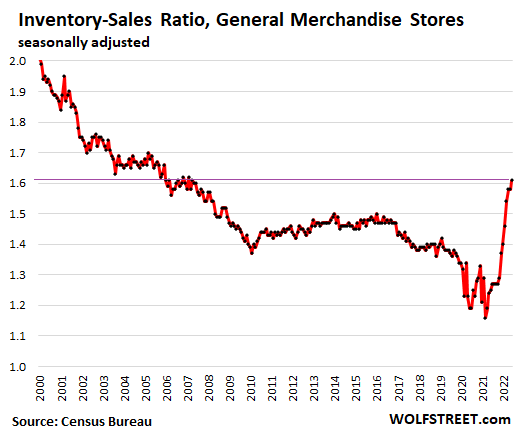
No comments:
Post a Comment
Note: Only a member of this blog may post a comment.